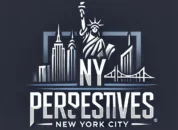Some Key Features in the Video:
Times Square
In the 1960s, Times Square stood at the beating heart of New York City—a pulsing, neon-lit crossroads where glamour met decay, and the energy of an ever-changing city spilled into every corner. By day, the square still glimmered with echoes of its golden past: massive billboards flashing the latest films, Broadway marquees advertising stars of stage and screen, and streams of commuters, tourists, and dreamers brushing shoulders on 42nd Street.
But as the sun went down, a different Times Square emerged. The postwar boom was fading, and the city’s famed entertainment district was shifting. Many of the grand old theaters had been converted into grindhouses, burlesque clubs, and adult cinemas. The air was thick with cigarette smoke, jazz notes, and the hum of restless ambition. It was an age of contradiction—where Broadway musicals like Hello, Dolly! and Fiddler on the Roof shone just a few blocks from flickering marquees advertising B-movies and late-night shows.
Amid the chaos, Times Square remained a powerful symbol of New York’s unfiltered character—vibrant, unruly, and alive. The flashing Coca-Cola sign and the ever-changing movie posters gave the square its electric personality, while news tickers rolled headlines that captured a nation in motion: civil rights marches, the Vietnam War, and the rise of rock and roll.
The 1960s were a decade of transformation, and Times Square mirrored that perfectly—a reflection of both the dreams and the disillusionment of America. Beneath the grit and glamour, it was a stage upon which the drama of modern urban life played out, twenty-four hours a day.
The Amsterdam Theatre: Broadway’s Crown Jewel
Standing proudly on 42nd Street in the heart of Manhattan, the New Amsterdam Theatre is more than just a Broadway venue—it’s a living monument to New York City’s theatrical legacy. Opened in 1903, the theater quickly became one of the most dazzling showplaces of its era, known for its opulent Art Nouveau design and intricate architectural details by the celebrated firm Herts & Tallant.
In its early years, the New Amsterdam earned fame as the home of the legendary Ziegfeld Follies, where glittering performances and larger-than-life stars defined the glamour of Broadway’s Golden Age. Its murals, mosaics, and ornate columns made it a marvel of turn-of-the-century craftsmanship, a space where art and entertainment met under one gilded roof.
But like much of Times Square, the theater fell into decline in the mid-20th century. After closing its doors in 1982, it sat dormant—its beauty fading behind locked doors and dusty chandeliers. Then came a modern fairytale ending: in the 1990s, the Walt Disney Company partnered with the city to restore the theater to its original splendor, sparking a broader revival of the Times Square district.
When the New Amsterdam reopened in 1997 with Disney’s The Lion King, it marked not only a rebirth for the building but also for Broadway itself. Today, the theater continues to host Disney’s “Aladdin,” enchanting new generations with the same sense of wonder that first filled its stage over a century ago.
The New Amsterdam Theatre isn’t just a venue—it’s a bridge between eras, where history, artistry, and imagination still shine as bright as the marquee lights outside.
Grand Central Terminal in the 1960s: A Cathedral in Transition
In the 1960s, Grand Central Terminal remained one of New York City’s most iconic landmarks—an awe-inspiring cathedral of travel where marble met movement, and sunlight streamed through towering arched windows onto a million daily stories. Yet beneath its grandeur, the station was facing one of the most uncertain decades in its history.
Opened in 1913 as a triumph of Beaux-Arts architecture, Grand Central had long symbolized the modern age—an engineering marvel filled with elegance, precision, and pride. But by the 1960s, the golden age of rail travel was waning. Jet planes and highways were pulling Americans away from the rails, and the once-glamorous terminal had grown tired. Paint peeled from its celestial ceiling, its chandeliers dimmed with decades of soot, and the main concourse echoed not with excitement but fatigue.
Still, Grand Central never lost its soul. Beneath the tarnish, it pulsed with life—businessmen rushing to catch commuter trains to Westchester, couples saying hurried goodbyes beneath the great clock, and drifters wandering through its subterranean corridors. Newsstands, shoeshine stations, and lunch counters kept the rhythm of the station alive, even as its owners, the New York Central Railroad, struggled financially.
Then came the shock of 1963: the demolition of Penn Station, another architectural masterpiece. Its destruction stirred outrage and a preservation movement that would eventually save Grand Central itself. When Jacqueline Kennedy Onassis joined the fight to protect the terminal in the 1970s, she was defending more than a building—she was defending the city’s soul.
In the 1960s, Grand Central was a paradox: a monument to the past standing in a city hurtling toward the future. Amid the cigarette smoke, echoing announcements, and shifting crowds, it remained what it had always been—a place of arrival, departure, and endless human drama.
Rockefeller Center in the 1960s: The Heartbeat of Modern Manhattan
In the 1960s, Rockefeller Center stood as the gleaming embodiment of New York City’s postwar confidence—a towering complex of art, commerce, and culture that symbolized both the city’s corporate might and its creative soul. Rising proudly between Fifth and Sixth Avenues, the 19-building complex was already a landmark of architectural innovation and urban design, but in the 1960s, it became something more: a symbol of modern America.
By day, Rockefeller Center buzzed with the rhythm of business. Suited executives hurried through its limestone corridors to offices in the RCA Building (now the GE Building), home to the National Broadcasting Company (NBC). Inside, television was rewriting entertainment history—shows like The Tonight Show and The Huntley–Brinkley Report broadcast from Studio 6B, sending the pulse of New York into living rooms across the nation.
Outside, the famous Prometheus statue gleamed above the Lower Plaza, overlooking the sunken ice-skating rink, which remained one of Manhattan’s most romantic winter scenes. Tourists and locals mingled beside the Channel Gardens, where fountains and floral displays brought bursts of color to the urban canyon.
But Rockefeller Center was also a gallery in motion. Its walls and public spaces displayed the best of Art Deco design and modernist sculpture, capturing the optimism and clarity of a nation in flux. Even amid the social upheavals of the 1960s—civil rights marches, political tensions, and generational change—Rockefeller Center retained a sense of balance, order, and purpose.
Each December, the lighting of the Rockefeller Christmas Tree drew thousands to Midtown, its shimmering lights reflecting off the surrounding skyscrapers—a tradition that had by then become an American ritual. Beneath its glow, skaters circled the rink as the city hummed around them, a living symbol of continuity in a decade defined by transformation.
Rockefeller Center in the 1960s was more than a place—it was a statement of faith in the city’s future. Amid the rush of progress and the roar of mid-century ambition, it stood as New York’s enduring promise: that beauty, art, and enterprise could coexist, side by side, in perfect harmony.
*****************************************************************************************************************************************


